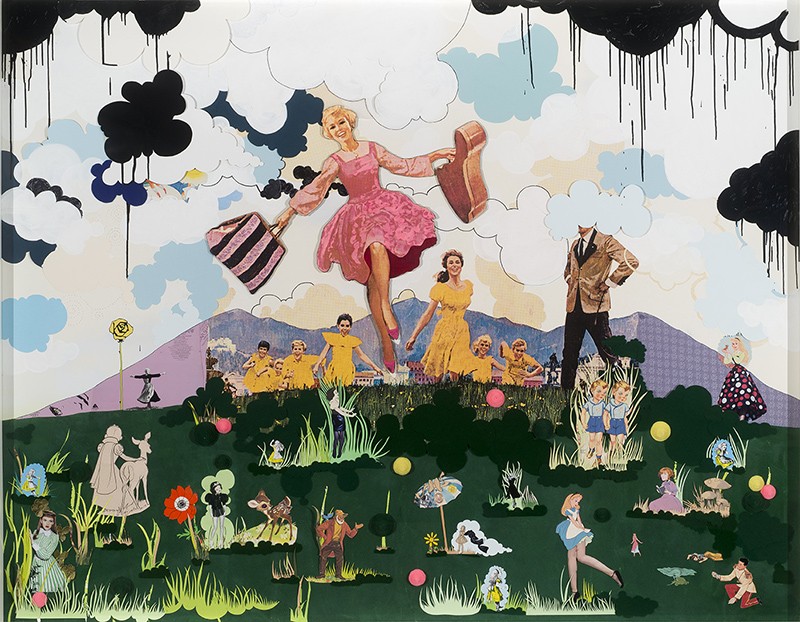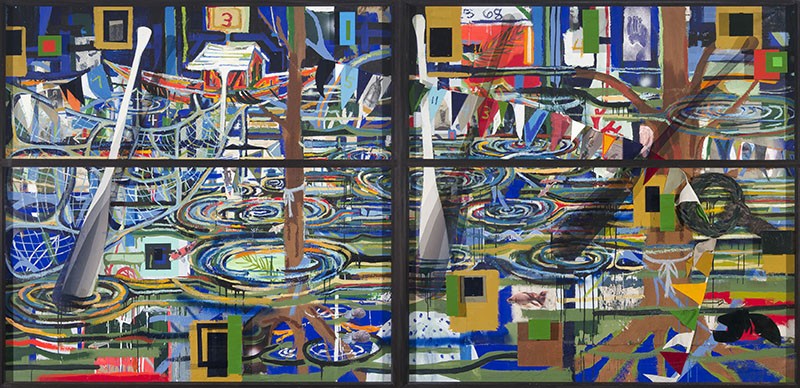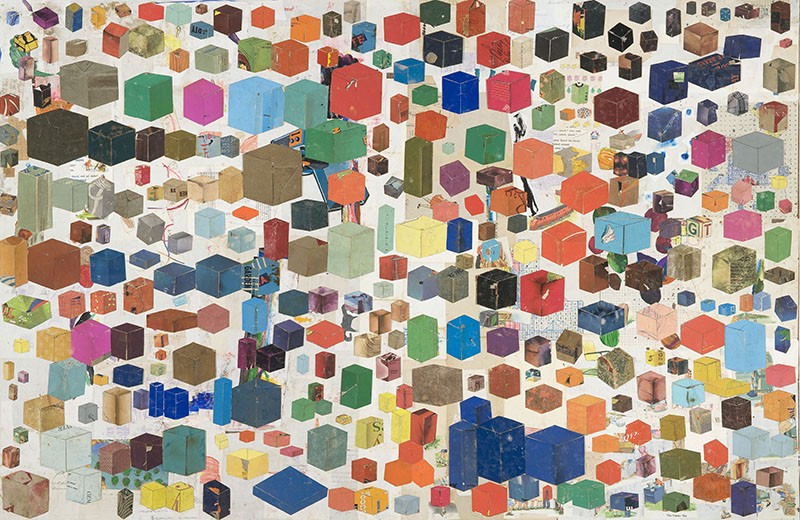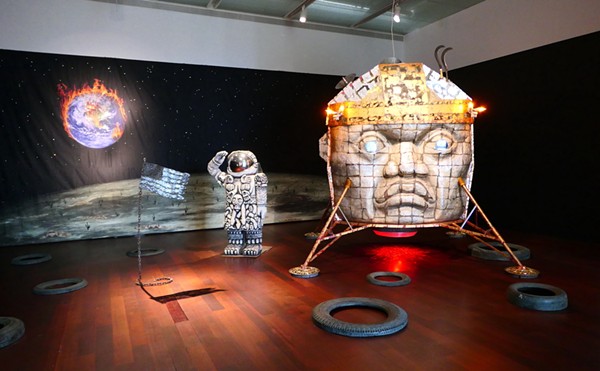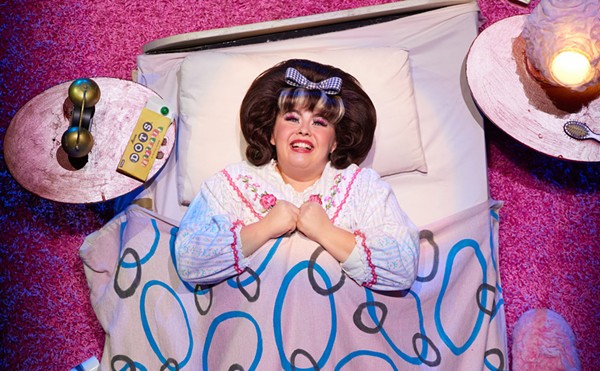In the art world, the McNay's Guitar and Wine Glass (1912) by Pablo Picasso is a superstar. Not only regarded as one of the earliest fine art collages, it's also considered the first to incorporate a newspaper. That's why it recently starred in both "Picasso: Guitars 1912-1914" at New York's Museum of Modern Art and "The Shock of the News" at the National Gallery of Art in Washington, D.C.
Currently, the influential collage, part of founder Marion Koogler McNay's original bequest in 1950, is anchoring "Recycled, Repurposed, Reborn: Collage and Assemblage," on view through September 6. This small work made from cut newspaper, wallpaper, sheet music and faux-wood paper has played a significant role in shaping the permanent collection of the state's first private modern art museum.
"We featured Guitar and Wine Glass in the 60th anniversary exhibit, but we brought it back for this show because it's the reason why the McNay has long put an emphasis on collecting collages and showing why collage has been such an important development in modern art," William J. Chiego, McNay director, who just announced his departure next year, told the San Antonio Current.
"We wanted to show off our strength in collage, and we were able to bring works together from all areas of the collection, including paintings, sculpture, prints, drawings and the Tobin Collection of Theatre Arts," Chiego said.
Alongside some of the best-known names in American art, several San Antonio artists are included, a tribute to the city's DIY tradition of making the best of what you have. The McNay defines collage as "the imaginative combining of disparate, often ephemeral materials or detritus to create a work of art."
In Guitar and Wine Glass, Picasso pasted in a drawing likely done by him, but the patterns of the faux-wood paper probably aren't his. In the scrap of newspaper, he cut off the text after the "u" in Le Journal, suggesting a "game" or a "gamble." The story below is about a crisis in the Balkans and may have been a challenge to Georges Braque, his friend and rival in inventing cubism. Braque is credited with inventing papier collé, which is a collage that uses paper exclusively.
Robert Motherwell, who has the most works in the show, is the best-known American artist to use papier collé. He regarded collage as the "20th century's greatest creative innovation" and critic Robert Hughes thought Motherwell was the most original collagist after Matisse. Motherwell's primary innovation was his use of the torn edge, such as the ragged Suchard chocolate box mailer in The Emmerich Collage and a clipping ripped from The Times, London, August 6.
Another major American artist, Robert Rauschenberg, the native of Port Arthur who had a Texas Sesquicentennial exhibit at the McNay in 1986, pulled topical images — sports figures, satellite dishes, animals, airplanes — from several sources that he combined in Rush #5 from the Cloister Series to form a quilt-like snapshot of the media landscape circa 1980. More mysterious is the small Black Mail (1958) with a winter landscape providing a backdrop for a small mirror and a gray postcard-like rectangle, perhaps a harbinger of bad news.
But the most spectacular and complex collage is by San Antonio artist Kelly O'Connor, who mines the psychic terrain of her childhood pop culture in Magnetic Fields (2009), dominated by a radiant Julie Andrews leading the von Trapp family over the Alps in The Sound of Music. Besides drawing from animated Disney fairy tales such as Sleeping Beauty and Alice in Wonderland, O'Connor also incorporates Judy Garland from The Wizard of Oz in a glitzy yet troubling trip through girl-power fantasyland. Clouds dripping or maybe bleeding black reveal a dark underside to this feminine version of the American Dream.
Best-known for his vividly colored portraits of pachucos, San Antonio artist César Martínez used sepia-toned, burnt and black-painted found wood for his poignant Cono's Christmas Buck (South Texas Lascaux) (1993). With antlers and deer heads etched into the wood, memories of a holiday hunting trip in Webb County are evoked by flattened, rusted, bullet-riddled beer cans and bits of scratched-in graffiti.
Other San Antonio artists include Kent Rush, who sends a subtle line of cowboys riding across the horizon line in his untitled collage with acrylic, charcoal and graphite on panel used to make it look like burnished and weathered metal. Part of a torn shirt set within a burning-red, roiling plane becomes the centerpiece for Reginald Rowe's mythic Oracle I. Mark Schlesinger, whose public art graces new sections of the River Walk, employs rolled-up pink vinyl for charming effect in Coco (2004). Henry Rayburn memorializes the pleasures of Paris with small architectural details in Place de L'Opera.
Radcliffe Bailey uses water-related imagery including ships, fish, ripples and oars etched on the glass covering the epic Procession (2005) to chart the African diaspora, trans-Atlantic slave trade and waterways of the South. An old family portrait, a medical diagram of an eye and a photo of a UFO tell a complicated family story in Legba (2003).
From the Tobin Theatre Collection are several set designs. Douglas Schmidt, this year's winner of the Robert L. B. Tobin Award for Sustained Excellence in Theatrical Design at the Theatre Development Fund/Irene Sharaff Awards in New York, developed his 1972 scene design for Grease around high school yearbook photos and portraits of James Dean. Natalia Gontcharova's Spanish Dancer (1916) is considered one of the Russian constructivist designer's masterworks.
Collage goes three-dimensional in assemblage sculpture, such as Texas artist Jim Love's smiling Choir Director (1959) and Ed and Nancy Kienholz's pot of gold chocolate coins. The gallery is too small for the McNay's more monumental works, such as Leonardo Drew's epically overstuffed Number 33A (1999). For collage artists, putting seemingly unrelated images and objects together unlocks new worlds of meaning.
Recycled, Repurposed, Reborn: Collage and Assemblage
$5-$10, 10am-4pm Wed, 10am-9pm Thu,, 10am-4pm Fri, Noon-5pm Sun, 10am-4pm Tue, McNay Art Museum, 6000 N. New Braunfels Ave., (210) 824-5368, mcnayart.org
Through Sept. 6

